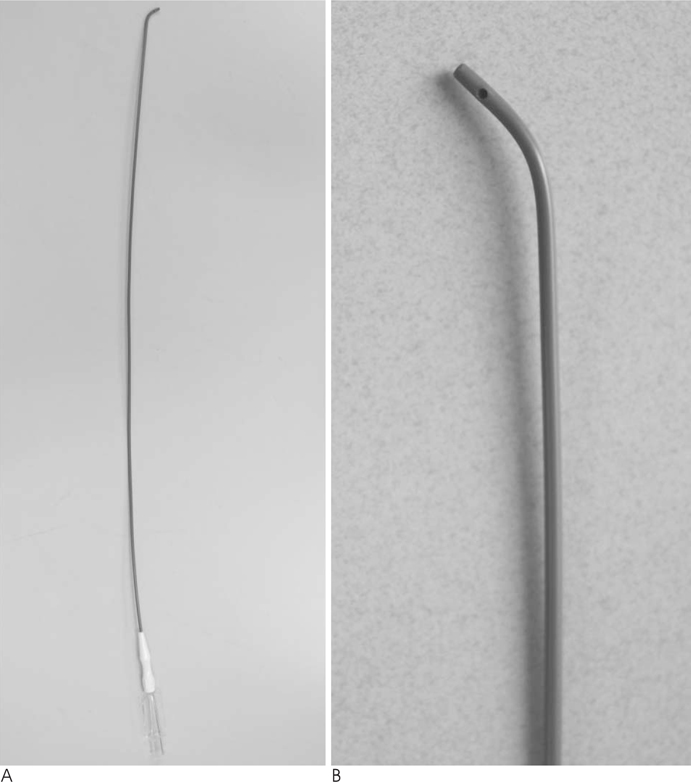J Korean Soc Radiol.
2011 Apr;64(4):317-323. 10.3348/jksr.2011.64.4.317.
Usefulness of a Biliary Manipulation Catheter in Percutaneous Transhepatic Biliary Drainage
- Affiliations
-
- 1Department of Radiology, Virginia University Health Center, 1215 Lee Street, Charlottesville, VA 22908, Unites States.
- 2Department of Radiology, Ajou University School of Medicine, Korea. jaeikbae@naver.com
- KMID: 1443533
- DOI: http://doi.org/10.3348/jksr.2011.64.4.317
Abstract
- PURPOSE
To evaluate usefulness of a manipulation catheter in percutaneous transhepatic biliary drainage (PTBD).
MATERIALS AND METHODS
A biliary manipulation catheter was used for the aspiration of retained bile and lesion crossing during an initial PTBD in 91 consecutive patients over a 6 month period. This catheter allowed for a 0.035 inch guide wire made of 5F short steel braided polyurethane. The terminal 1 cm segment was tapered and 45degrees angulated. Two side holes were made in the terminal segment to facilitate the aspiration of bile. The safety of this procedure was evaluated based on whether the catheters caused complications during insertion and manipulation, and whether cholangitis was aggravated after the procedure. Effectiveness of the procedure was evaluated based on the ability to aspirate retained bile and to cross the lesion.
RESULTS
Both the insertion of a 0.035 inch hydrophilic guide wire and aspiration of sufficient retained bile were successful with the catheter. Crossing the common bile duct (CBD) lesion had a 98.1% success rate during the initial PTBD. Crossing the hilar obstruction lesion was had a 94.7% success rate to the CBD and 92.1% to the contralateral lobe. Cholangitis improved in 97% of cases, and aggravated transiently in only 3% of cases after PTBD.
CONCLUSION
A biliary manipulation catheter should be considered as a useful tool for a safe and effective PTBD, attributed to the facilitation of bile aspiration and lesion crossing.
MeSH Terms
Figure
Reference
-
1. Venbrux AC, Ignacio EA, Soltes AP, Washington SB. Malignant obstruction of the hepatobiliary system. In : Baum S, Pentecost MJ, editors. Abram's angiography interventional radiology. 2nd ed. Philadelphia: Lippincort Williams & Wilkins;2006. p. 553–559.2. Gordon RL. Benigh biliary obstruction. In : Baum S, Pentecost MJ, editors. Abram's angiography interventional radiology. 2nd ed. Philadelphia: Lippincort Williams & Wilkins;2006. p. 536–552.3. Harbin WP, Mueller PR, Ferrucci JT. Transhepatic cholangiography: complications and use patterns of the fine-needle technique: a multi-insitutional survey. Radiology. 1980; 135:15–22.4. Clark CD, Picus A, Dunagan WC. Bloodstream infections after interventional procedures in the biliary tract. Radiology. 1994; 191:495–499.5. Sacks-Berg A, Calubiran OV, Epstein HY, Cunha BA. Sepsis associated with transhepatic cholangiography. J Hosp Infect. 1992; 20:43–50.6. Venbrux AC, Osterman FA Jr. Percutaneous management of benign biliary strictures. Semin Intervent Radiol. 1996; 13:207–214.7. Lameris JS, Obertop H, Jeekel J. Biliary drainage by ultrasound-guided puncture of the left hepatic duct. Clin Radiol. 1985; 36:269–274.8. Günther RW, Schild H, Ehelen M. Percuntaneous transhepatic biliary drainage. Experience with 311 procedures. Cardiovasc Intervent Radiol. 1988; 11:65–67.9. Van Delden OM, Lameris JS. Percutaneous drainage and stenting for palliation of malignant bile duct obstruction. Eur Radiol. 2008; 18:448–456.10. Yedlicka JW, Tadavarthy SM, Letournean JG, Castaneda F, Castaneda-Zuniga WR. Biliary tract intervention. In : Castaneda-Zuniga WR, editor. Interventional radiology. 3rd ed. Baltimore: Williams & Wilkins;1997. p. 1439–1608.11. Gibson RN. Percutaneous transhepatic cholangiography and biliary drainage. In : Adam A, Gibson RN, editors. Practical interventional radiology of the hepatobiliary system and gastrointestinal tract. Kent: Edward Arnold;1994. p. 13–31.12. Garcia-Vila JH, Bordon F, Gonzalea-Anon M, Ambit S, Cortes V. Endoluminal biopsy of the bile duct with a biliary manipulation catheter. J Vasc Interv Radiol. 1999; 10:1394–1396.13. Wada K, Takada T, Kawarada Y, Nimura Y, Yoshida M, Mayumi T, et al. Diagnostic criteria and severity assessment of acute cholangitis: Tokyo guidelines. J Hepatobiliary Pancreat Surg. 2007; 14:52–58.
- Full Text Links
- Actions
-
Cited
- CITED
-
- Close
- Share
- Similar articles
-
- Percutaneous transhepatic biliary drainage
- Subcutaneous Implantation Metastasis of a Cholangiocarcinoma of the Bile Duct after Percutaneous Transhepatic Biliary Drainage (PTBD)
- Peritonitis Caused by Internal Migration of the Percutaneous Transhepatic Biliary Drainage Catheter
- Percutaneous biliary drainage in acute suppurative cholangitis with biliary sepsis
- Percutaneous transhepatic biliary drainage



